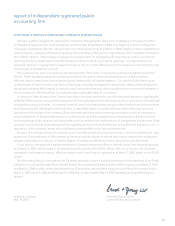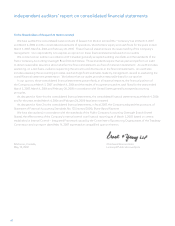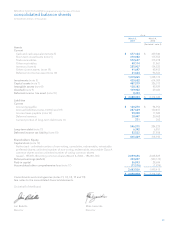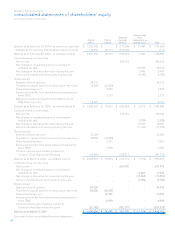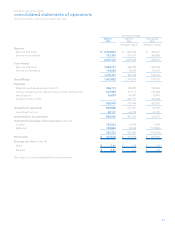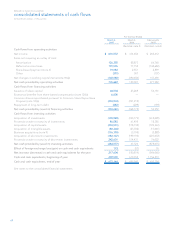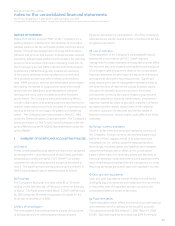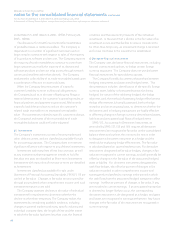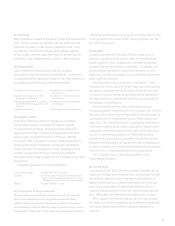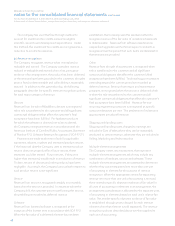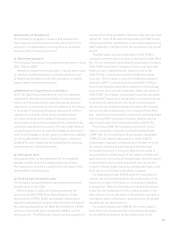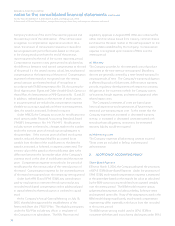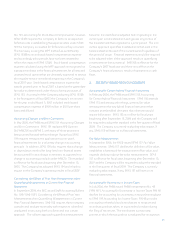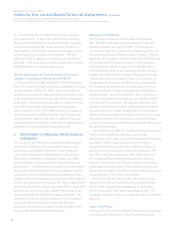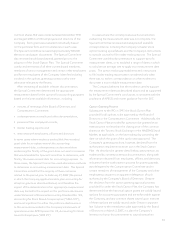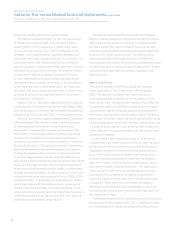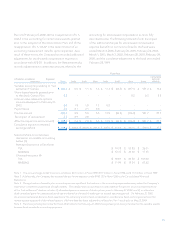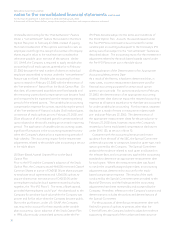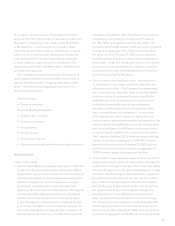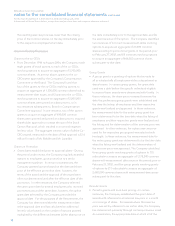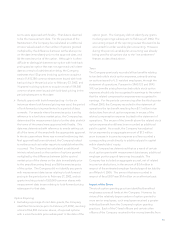Blackberry 2007 Annual Report Download - page 71
Download and view the complete annual report
Please find page 71 of the 2007 Blackberry annual report below. You can navigate through the pages in the report by either clicking on the pages listed below, or by using the keyword search tool below to find specific information within the annual report.69
(q) Research and development
The Company is engaged in research and development
work. Research and development costs, other than for the
acquisition of capital assets, are charged as an operating
expense of the Company as incurred.
(r) Government assistance
The Company has received no government assistance in fiscal
2007, 2006 and 2005.
Assistance related to the acquisition of capital assets used
for research and development is credited against the cost
of related capital assets and all other assistance is credited
against related expenses as incurred.
(s) Statements of comprehensive income (loss)
SFAS 130, Reporting Comprehensive Income, establishes
standards for the reporting and display of comprehensive
income and its components in general-purpose financial
statements. Comprehensive income is defined as the change
in net assets of a business enterprise during a period from
transactions and other events and circumstances from
non-owner sources, and includes all changes in equity
during a period except those resulting from investments by
owners and distributions to owners. The reportable items of
comprehensive income are cash flow hedges as described in
note 19, and changes in the fair value of investments available
for sale as described in note 5. Realized gains or losses on
available-for-sale investments are reclassified into earnings
using the specific identification basis.
(t) Earnings per share
Earnings per share is calculated based on the weighted
average number of shares outstanding during the year.
The treasury stock method is used for the calculation of the
dilutive effect of stock options.
(u) Stock-based compensation plans
The Company has stock-based compensation plans, which
are described in note 12(b).
Effective March 5, 2006, the Company adopted the
provisions of SFAS 123(R) Share-Based Payment. Under
the provisions of SFAS 123(R), stock-based compensation
expense is estimated at the grant date based on the award’s
fair value as calculated by the Black-Scholes-Merton (“BSM”)
option-pricing model and is recognized rateably over the
vesting period. The BSM model requires various judgmental
assumptions including volatility, forfeiture rates and expected
option life. If any of the assumptions used in the BSM model
change significantly, stock-based compensation expense may
differ materially in the future from that recorded in the current
period.
The BSM option-pricing model used in SFAS 123(R) is
consistent with that used in pro forma disclosures under SFAS
No. 123, Accounting for Stock-Based Compensation, however,
SFAS 123(R) requires the Company to factor in an expected
forfeiture rate in establishing the expense while under
SFAS 123 the Company accounted for forfeitures as they
occurred. The Company is using the modified prospective
transition (“MPT”) method as permitted by SFAS 123(R) to
record stock-based compensation expense and accordingly
prior periods have not been restated to reflect the impact of
SFAS 123(R). Stock-based compensation expense calculated
using the MPT approach is recognized on a prospective basis
in the financial statements for all new and unvested stock
options that are ultimately expected to vest as the requisite
service is rendered beginning in the Company’s fiscal 2007
year. Stock-based compensation expense for awards granted
prior to fiscal 2007 is based on the grant-date fair value as
determined under the pro forma provisions of SFAS 123.
Prior to fiscal 2007, the Company accounted for stock-
based compensation using Accounting Principles Board
(“APB ”) No. 25, Accounting for Stock Issued to Employees
(“APB 25”) and related interpretations. Under APB 25,
compensation expense is measured as of the date on which
the number of shares and exercise price become fixed.
Generally, this occurs on the grant date and the award is
accounted for as a fixed award. If the number of shares and
grant price are not fixed as of the grant date, the stock option
is accounted for as a variable award until such time as the
number of shares and/or exercise prices become fixed, or the
stock option is exercised, is cancelled, or expires.
For fixed awards under APB 25, when the exercise price
of stock options granted equals the fair market value of the
shares on the date of the grant, no compensation expense
is recognized. When the exercise price of the stock options
is less than the market price of the underlying stock on the
date of grant, this intrinsic value of the award on that date is
recorded as stock compensation expense and is recognized
rateably over the vesting period.
For variable awards under APB 25, the intrinsic value of
stock options is remeasured each reporting period based
on the difference between the fair market value of the


